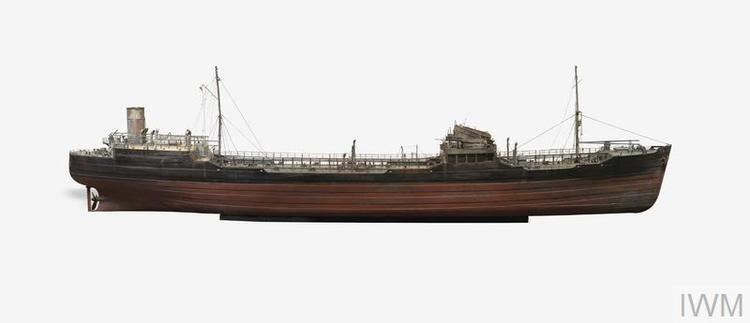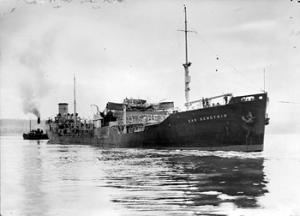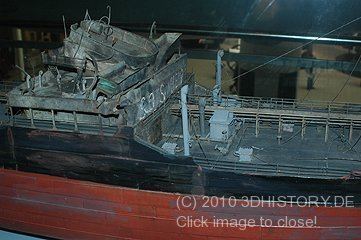Name San Demetrio Out of service 1942 Launched 11 October 1938 Draft 8.25 m | Yard number 52 Homeport London Weight 3.662 tons | |
 | ||
MV San Demetrio was a British motor tanker, notable for her service during the Second World War. She was built in 1938 for the Eagle Oil and Shipping Company. In 1940 she was damaged by enemy action in mid-Atlantic, abandoned by her crew but later re-boarded and successfully brought into harbour. She was the subject of a 1943 feature film, San Demetrio London, one of the few films that recognised the heroism of the UK Merchant Navy crews during the War.
Contents
- Convoy HX 84
- Attack by the Admiral Scheer
- Re boarding
- Sinking
- Film
- Book
- Art depictions and museum holdings
- References

San Demetrio was one of several motor tankers of about 8,000 GRT built for Eagle Oil and Shipping in the latter 1930s. She was built by the Blythswood Shipbuilding Company of Glasgow, who had also launched her sister ships San Conrado in 1936 and San Cipriano in 1937.

Convoy HX-84
San Demetrio had loaded 11,200 tons of aviation fuel in Galveston, Texas and was bound for Avonmouth, England. She was one of 38 ships that joined Convoy HX-84 for the passage across the north Atlantic and left Halifax, Nova Scotia on 28 October 1940. The Wickes-class destroyer HMCS Columbia (I49) and Clemson-class destroyer HMCS St. Francis (I93) escorted the convoy out of Canadian home waters but once clear of the coast, the convoy's sole escort was the armed merchant cruiser HMS Jervis Bay — a converted passenger liner that had been armed with seven outdated BL 6 inch Mk VII naval guns and a pair of 3-inch (76 mm) anti-aircraft guns.
Attack by the Admiral Scheer

On 5 November 1940, the German cruiser Admiral Scheer found the convoy at 50°30′N 32°00′W and attacked immediately. Captain E.S.F. Fegen of HMS Jervis Bay steamed out towards the raider so as to delay the Admiral Scheer to allow the convoy to scatter and escape. Jervis Bay was completely outclassed, but she fought for 22 minutes before she was sunk with the loss of 190 of her crew. Their sacrifice, followed by a four-hour cat-and-mouse battle with the convoy freighter SS Beaverford enabled most of the merchantmen from Convoy HX-84 to escape. Fegen received a posthumous Victoria Cross.

Admiral Scheer now tried to sink as many of the convoy as possible before darkness fell. She hit San Demetrio with several shells that destroyed the bridge and poop deck and left the upper deck in flames. Despite both the exploding shells and the resultant fire, the ship's highly flammable cargo did not explode. Nevertheless, her Master, Captain Waite, believed that the fire could set off the aviation fuel at any moment so he gave the order to abandon ship. With the ship remaining under fire from the Scheer, the crew escaped in two lifeboats. Admiral Scheer then turned her attention to other ships of the rapidly scattering convoy.
Re-boarding

The two lifeboats separated in the night, and the lifeboat with the captain and twenty-five crew was picked up and taken to Newfoundland. The sixteen men in the other lifeboat, including Second Officer Arthur G. Hawkins and Chief Engineer Charles Pollard, drifted for 24 hours when they sighted a burning ship. To their surprise, they discovered that it was their own ship, San Demetrio. With few alternatives, the crew had to decide whether to risk death by exposure or to re-board and risk the fire. In the end they chose to remain in the lifeboat because the fire was too great and the weather too hazardous to attempt boarding, but after a second night in the boat and enduring a freezing North Atlantic winter gale, they regretted not re-boarding the tanker.
At dawn the following day, 7 November 1940, the San Demetrio was about 5 nautical miles (9 km) downwind so the crew set sail toward her and re-boarded. They fought the fire, repaired the port auxiliary boiler sufficiently to restart the ship's pumps and dynamos and repaired the auxiliary steering gear. No charts or navigational instruments had survived so the crew estimated a course from occasional glimpses of the sun. Her radio had not survived either. They managed to sail the tanker across the rest of the Atlantic, braving bad weather and U-boats. After seven days the San Demetrio reached waters off Ireland, from where they were escorted on to the mouth of the River Clyde, docking on 16 November 1940. They declined the offer of a tow from a tug because of the high cost.
Despite the damage and fire, only 200 tons of San Demetrio's highly volatile cargo had been lost. There was only one fatality, John Boyle, who had been injured jumping into the lifeboat after the original battle and gradually began to feel unwell. He was propped up in the engine room, to watch the gauges, but died of a haemorrhage after two days. He was posthumously awarded the King's Commendation for Brave Conduct.
Since the crew had received no assistance from another vessel, in the ensuing case in the Probate, Divorce and Admiralty Division of the High Court, they were able to claim the salvage money from the insurers for the ship and cargo. The oil and freight cargo were valued at £60,000. The ship herself, almost new, was worth £250,000. The High Court awarded the claimants £14,700 salvage money: £2,000 of it going to Second Officer Hawkins; £1,000 to the estate of John Boyle. Another £1,000 went to 26-year-old Oswald Ross Preston, an American seaman, because he played a "magnificent" part when the battle started. Hawkins was also given the tattered Red Ensign of the ship.
Salvage Payouts:
Second Officer Hawkins was awarded the OBE for his gallantry. Chief Engineer Charles Pollard and Deck Apprentice John Lewis Jones each received the Lloyd's War Medal for Bravery at Sea. San Demetrio was repaired and returned to service.
Sinking
On 14 March 1942 San Demetrio sailed unescorted from Baltimore, Maryland bound for the UK via Halifax, Nova Scotia with a cargo of 4,000 tons of alcohol and 7,000 tons of aviation spirit. On 17 March she was northwest of Cape Charles, Virginia when the German submarine U-404 torpedoed and sank her. 16 crew and three DEMS gunners were lost, and six crew wounded, but survivors managed to launch two lifeboats. Two days later the US tanker SS Beta rescued the Master, 26 crew and five DEMS gunners and took them to Norfolk, Virginia. The Master, Conrad Vidot, was awarded the Lloyd's War Medal.
Film
The ship's part in Convoy HX-84 was made into a film, San Demetrio London in 1943, starring Walter Fitzgerald, Mervyn Johns, Ralph Michael, and Robert Beatty. It was one of the few films to recognise the heroism of British Merchant Navy crews during the war.
Book
One of the ship's crew, Able Seaman Calum Macneil, wrote a book called San Demetrio, which was published by Angus and Robertson in 1957. It is a personal account of leaving his previous ship and joining the crew of the San Demetrio. He was one of the crew who abandoned the ship then re-boarded during the voyage of Convoy HX-84. During the war an account "The Story of San Demetrio" was published to boost morale.
Art depictions and museum holdings
A wartime poster entitled "San Demetrio gets home" was issued by the Post Office Savings Bank. It featured a painting of the ship by Charles Pears. She is also depicted in two works by marine painter Norman Wilkinson. The 'San Demetrio' at the Jervis Bay action, 5 November 1940 is held by the National Maritime Museum (NMM), while The Crew Reboarding the Tanker 'San Demetrio', 7 November 1940 is held by the Imperial War Museum (IWM). The NMM collection also includes the ship's bell. The IWM collection includes the compass (pictured right), a fragment of her wheel, and two models of the ship. One of these models was made by Ealing Studios for use in the making of the film San Demetrio London. The compass along with two newspaper cuttings (pictured right) were stored in John Jamieson's father's tenement from 1940 until 1972 at 600 Paisley Road West, Glasgow, then in Southampton, before being donated to the Imperial War Museum.
